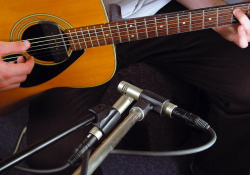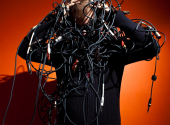
The Handbook for Electro Acoustic Guitarists, Chapter 11: Home Recording
Are you in need of a decent recording, maybe for a competition application or background music for your friend's video, and you want it fast? Not being (and not wanting to be) a sound engineer? The question is, can we make it DIY, cheaper and avoid a high-end studio? Of course, we can, and it's quite easy! Just follow a few basic rules and you can record your music at home in a sufficient quality.
I have been asked about simple home recording quite a lot because I've spent almost a third of my life on the road, so I've literally been forced to find ways to record music in field conditions at hotels and other inadequate spaces. Gradually, a few rules emerged to ensure you won't feel embarrassed to release such a recording. So let's expand those audio-paradigms a bit and test the principle of the uncompromising mathematician Vifred Pareto who proved back in the 19th century that 80% of outputs result from 20% of inputs – if you know how to do it and, most importantly, are able to set your priorities (which have a major impact on your outcome).
In fact, the entire recording community is subject to a highly infectious epidemic of "HiFism", where many online “experts” will advise you on what iconic preamps, unbeatable compressors and active silver cables you need to use. I well remember a scene when an unnamed, later quite famous producer was comparing expensive microphones, his enthusiastic claque was gushing over all sorts of nuances, and after three samples I had only one thought – when will he finally sing something properly instead of that annoying chatter!
Since this is the first and most important point – YOU determine the quality of the recording by your performance. Your influence is many times higher than the most expensive equipment. And, to be frank, I still don't understand why people spend incredible money, energy, time and effort trying to achieve 20% improvement when by simply practising they can easily get 80%. So, work on yourself instead of wasting (not only) money. But, back to our point, how to record an acoustic guitar at home?
Microphone
In ten chapters of this Handbook we have learned that the best sound comes from the microphone, plus we don't have to deal with that unfortunate feedback at home, so hooray. It's good to have a single condenser large-diaphragm microphone. There's almost plethora of them nowadays, from the cheap to the expensive ones, but I can tell you that I've never seen a microphone that didn't meet the demands of home recording (think of 80/20). Another option is a small-diaphragm condenser, called a pencil. I only use them to supplement the basic sound of a large-diaphragm. So where to place them? There are so many ways to do that. Fortunately, Pareto was really a genius and whoever doesn't like or have time to experiment, point the microphone from a distance of about 30 cm to the 14th fret of the guitar and that's it. I didn't believe it either and wanted to see for myself more than once, until the sound engineers made fun of me. Anyway, I came to the conclusion that this position works best in most cases and I could have saved myself a lot of time. I place the pencils in the so called XY pattern and only use them when I'm recording just one solo guitar. Oh wait, you only record one, right?
Tracks
That's another wizardry. Always double (duplicate) the backing guitars. That is, record the same part twice and spread it left and right across the panorama. You'll get a stereo sound that no effect or sophisticated multi-mic placement method can handle. No need to worry about it, but practice. The first time I was in the studio, I played my guitar part huffing and puffing, when the sound engineer said: good, now do the same thing again. What? I can't play it the same way... but yes, you can and your recording will sound infinitely better if you do this instead of relying on any expensive equipment. Great, more stripes, more Adidas, so I'll multiply it even more and it'll be even better... Well, it won't. I've tried that for you, too, and one of my first recordings featured 24 tracks of acoustic guitar and while it was interesting, it certainly wasn't for the good. Pragmatically, I gradually arrived at a method – double the accompaniments with a big membrane, spread left/right and add XY pencils to make a bit more room for a solo. For more serious recordings I always add a pickup line to the mix (but that's for a longer detailed talk and not needed for home recording).
Postprocessing
Editing or effects or mixing and mastering. This topic has been covered in reams of paper, and I personally never liked spending hours researching effects settings and what they do to a recording. However, I don't want to chase sound engineers with every little thing, so I gradually developed a "yahoo mixing" method. First, of course, I adjust the volume(s) and then deploy another powerful piece of magic called a multiband compressor. So mixing and mastering in one is a one-click job. I use a free plugin without investigating the settings too much, one preset just works fine so I don't tinker with it anymore.
Then all that's left to do is spice it up a bit with reverb and we're 80% done in literally seconds. The other 20% is hard work, requiring a lot of experience, knowledge and possibly better equipment. But since we are still talking about recordings that have no ambition to take the world's cultural heritage to a new level, there is no need to overdo it. I have also prepared a short example of how the above operations will affect the sound. So, first one mic mono, then XY pencils stereo, then left/right stereo, multiband compressor and reverb (recorded and "mixed" in five minutes, including a set-up).
Formats
I'll try not to offend the experts, knowing that we're still dealing with home recording in acoustically usually inadequate spaces and with cheap equipment, so overdoing it with the quality of the files you pick up is counterproductive in this case, and the only thing you really get is less hard drive space. Feel free to stick to the mantra of 16 bit/44.1 kHz or CD quality. 24 bits will help with quieter sounds, 48 kHz if the music is accompanying a video. But even that is not strictly necessary. I would choose adequate equipment with that in mind as well.
Nowadays, sound cards are like two peas in a pod and development continues at such a pace that they all usually do their job more than adequately. I've taken a bit of a leap, as I assume at least a rudimentary knowledge of the recording process, programs and sound cards. If you are not familiar with it, I strongly suggest you look into it. Just the basics of editing, setting up and exporting files will dramatically increase your productivity. All you care about is the recording of audio. You can leave the other 80% of the manual pages to the sound engineers.
Recorders
Well, yeah, but I don't understand it at all and don't have time to read it because I have to practice! I commend that, of course, and that's exactly what recorders are for. For acoustics, I recommend having the mics in XY pattern, pointing at the 14th fret, adjusting the level so you don't overdrive on the loudest beats and pressing Record. The recorder is clearly the device with the best price/performance ratio. Its recordings can be of surprising quality, and personally I have been using the Zoom H1 for many years, mainly because I can have a recording (see cover picture) ready in literally seconds. I've also gradually incorporated a few little tricks, like not using any stand but just putting the H1 on the table. So that it doesn't pick up the hum of the laptop, I pad it with a piece of foam. The round vocal pop filter mounted on the flute stand (because my desk has a thick top and legs, so a regular clamp won't fit) is there because in that position you have your head pretty close to the mic and you're trying not to breath on it, which probably cannot be done for very long. So I use a pop filter as protection from dynamic breathing shocks. Such details as non-squeaky chairs are probably not even necessary to mention. This is exactly how I make simple slideshow background music for friends, for example.
Mobility
And what if I have a new expensive mobile phone, it records great, doesn't it? Yes, even that is an option nowadays. I use my mobile to record my ideas and the quality has gone up considerably in the last few years. Only with those pinhead-sized microphones, you probably won't make a complete hit parade even for home recording. But there are various gadgets that can turn a mobile phone into a quality recorder and in conjunction with the Garage Band app, for example, you can make a lot of music. Another good mobile tip is also the iRig and you have the picking sorted out right on your mobile. So home recording doesn't always have to look like an internet meme, but it can be fun with decent results. With this bonus chapter, we say goodbye to our series and now the electroacoustic fame is just waiting for you, so enjoy (and handle) it!
If you have found an error or typo in the article, please let us know by e-mail info@insounder.org.








